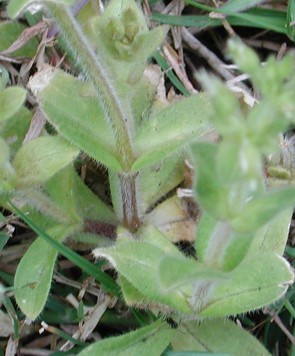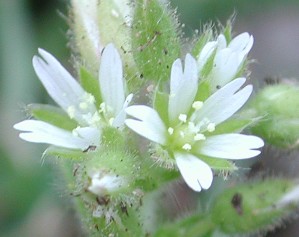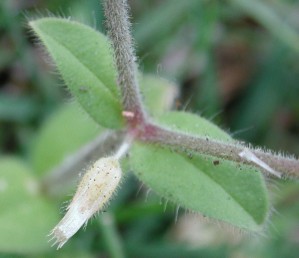Scientific name: Cerastium glomeratum Thuill.
Synonym: Cerastium viscosum auct. non L.Common name: Mouse-eared chickweedFamily: CaryophyllaceaeOrigin:Native of Europe. Habit:Annual herb with soft stems growing to a height of approximately 15 cm. Habitat:Found largely in costal areas, in lawns and gardens and other moist and/or shady areas. General description:Stems and leavesStems and leaves are covered in simple, glandular hairs and so are sticky to touch. Stems are erect or ascending. Leaves are oppositely arranged with leaf stalks (petioles) to 1.2 cm on the larger basal leaves. Upper leaves are smaller and without stalks (sessile). Leaves range from 0.5-3 × 0.3-1.5 cm in size. Leaves are generally oval (elliptic) in shape with a rounded apex and a small point at the tip. Flowers and fruitThe flowers have four or five white petals (4-5 mm long) with divided tips. Outside the petals, and in between them are, are five hairy sepals (also up to 4-5 mm long). Flowers are grouped into short branched inflorescences at the ends of the stems. Flowering occurs from winter through to spring. Fruits are cylindrical capsules (7-9 mm long), with 10 small teeth, which contain numerous seeds. Distinguishing characteristics:Soft stemmed erect or ascending herb with hairy leaves and stems, small white flowers and papery seed capsules. Can be confused with chickweed (Stellaria media), a closely related species. However, chickweed (Stellaria media) leaves are hairless and its upper leaves sometimes have distinct leaf stalks (petioles). Noxious status:Not noxious. Sources:Kleinschmidt, H.E., Holland, A. and Simpson, P. (1996). Suburban Weeds. 3rd Edition. Department of Primary Industries, Brisbane. Stanley, T.E. and Ross, E.M. (1983-1989). Flora of South-eastern Queensland. Volume 1. Department of Primary Industries, Brisbane. |
Brisbane
St Lucia, QLD 4072
+61 7 3365 1111
© 2009 The University of Queensland





